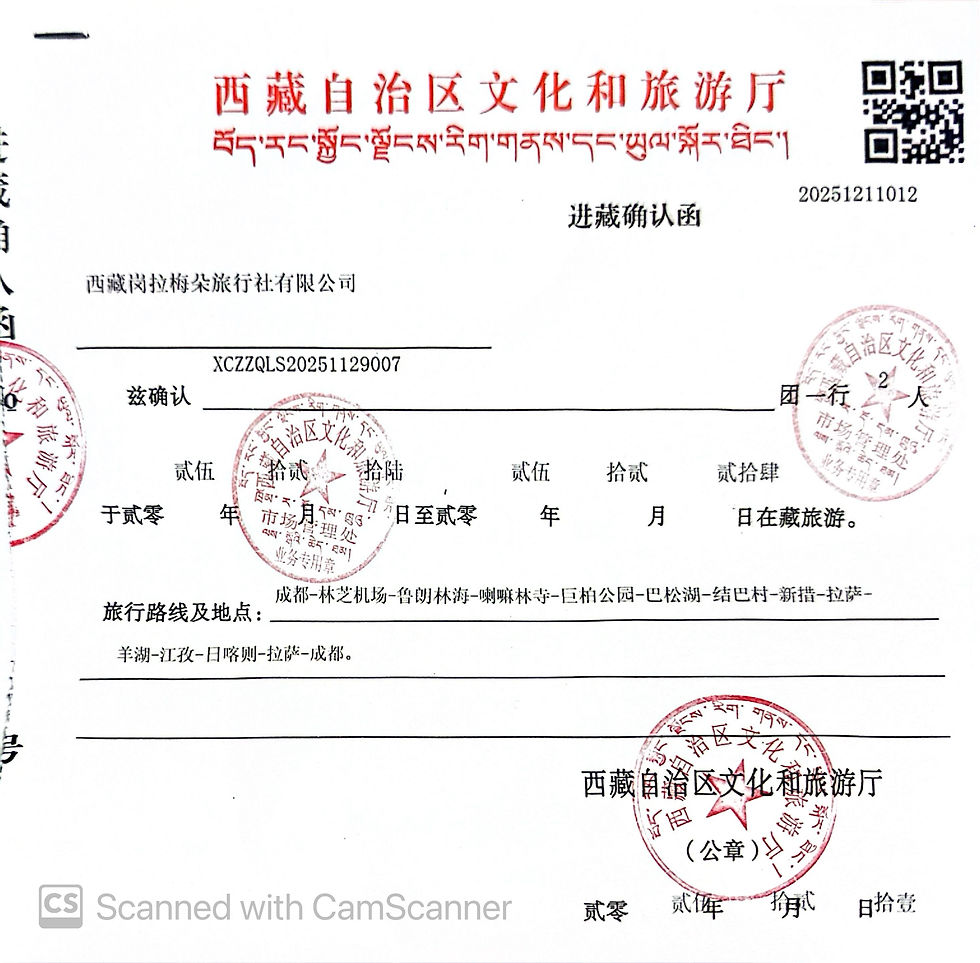Discover the Best Time to Visit Tibet | A Traveler’s Guide
- tibetantours
- Apr 10
- 4 min read
Updated: May 31

Discover the Best Time to Visit Tibet | A Traveler’s Guide
Tibet, a mystical land nestled in the Himalayas, has long attracted adventurers, culture seekers, and spiritual travelers alike. Known as the “Roof of the World,” Tibet offers an unparalleled combination of awe-inspiring natural beauty, ancient monasteries, and sacred mountains. But when is the best time to visit Tibet to make the most of your journey? In this guide, we’ll explore the top times to visit, helping you plan the perfect Tibet tour.
1. Spring to Fall: The Ideal Time to Experience Tibet
Spring (April to May)
Spring in Tibet is a time of renewal. After the long winter, the Tibetan Plateau begins to thaw, and the weather becomes more inviting. If you prefer fewer crowds and pleasant temperatures, spring is a great time to explore Lhasa, Potala Palace, or Namtso Lake. The landscape comes alive with vibrant wildflowers, and the skies are clear, making it a fantastic season for photography and outdoor activities like trekking or visiting Tibetan monasteries.
Summer (June to August)
Summer is the most popular season to travel to Tibet, and for good reason. The weather is warmer, making it ideal for trekking, sightseeing, and mountain explorations. This is when Tibet’s famous festivals, such as the Shoton Festival and Saga Dawa, take place. Summer also offers the best conditions for visiting higher-altitude regions like Mount Everest or Everest Base Camp. However, expect more tourists during these months, particularly in Lhasa.
Autumn (September to October)
Autumn is often regarded as one of the best times to visit Tibet. The summer monsoons have passed, leaving behind clear, crisp skies. The weather is still warm enough to enjoy outdoor adventures, and the landscape transforms with stunning fall colors. If you’re planning to visit Mount Kailash, Lake Manasarovar, or Shigatse, autumn offers a balance of great weather and fewer crowds. It’s an excellent time for both trekking and cultural exploration, as the landscape is at its most picturesque.
2. Winter in Tibet: A Tranquil, Yet Cold Experience
Winter in Tibet is cold, with temperatures dropping well below freezing, especially in higher-altitude areas. While this may not be the best time for outdoor activities like trekking or climbing, it offers a quiet and peaceful experience, particularly in cities like Lhasa. The winter months are ideal for travelers interested in the spiritual side of Tibet, such as visiting remote monasteries or attending Tibetan New Year (Losar) celebrations, which typically occur in February or March. If you’re looking for a quieter and more introspective experience, winter might be perfect—but be prepared for the cold.
3. Cultural and Religious Festivals: An Unforgettable Experience
One of the most unique aspects of traveling to Tibet is the opportunity to witness its vibrant festivals, which bring Tibetan culture to life. Here are a few festivals you should consider timing your trip around:
• Losar (Tibetan New Year): A celebration of the Tibetan lunar calendar, Losar usually takes place in February or March. It’s Tibet’s most significant festival, with traditional ceremonies, dances, and feasts.
• Saga Dawa (May to June): This festival marks the birth, enlightenment, and death of the Buddha. Pilgrims from across Tibet gather at Mount Kailash to perform religious rituals. This is a spiritual and cultural highlight for those who wish to experience Tibet’s deep religious traditions.
• Shoton Festival (August): Held in Lhasa, this festival marks the end of the monks’ summer retreat. It’s celebrated with colorful parades, traditional Tibetan opera performances, and special prayers.
4. Preparing for Your Tibet Trip: What You Need to Know
• Altitude Considerations: Tibet is known for its high altitude, with many areas well above 3,000 meters (9,800 feet). Be sure to acclimatize gradually, starting with Lhasa, which sits at 3,650 meters. This will help you adjust to the thinner air and reduce the risk of altitude sickness.
• Packing for Tibet: The weather can be unpredictable, so pack wisely. Even during summer, the temperatures can drop significantly at night, especially in high-altitude regions. Bring layers of clothing, a warm jacket, sunscreen, a good pair of trekking shoes, and a hat to protect against the strong sun at high altitudes.
• Travel Permits: A Tibet Travel Permit is required for all travelers visiting Tibet, and it can only be arranged through an authorized travel agency. Plan ahead to ensure all necessary paperwork is in place before your trip.
5. Conclusion: Finding the Best Time for Your Tibet Tour
The best time to visit Tibet depends on your interests and what you want to experience. If you enjoy warm weather, festivals, and high-altitude exploration, summer and autumn are perfect for you. If you’re seeking a quieter and more introspective trip, winter offers a serene, peaceful experience. However, spring remains a favorite for many travelers, offering the perfect blend of good weather and fewer crowds.
Tibet’s rich culture, stunning landscapes, and spiritual significance will leave you with memories to last a lifetime, no matter when you visit. Plan your Tibet tour carefully, taking into account the climate, festivals, and your personal preferences, and get ready for an unforgettable journey!
By Tenzin






Comments